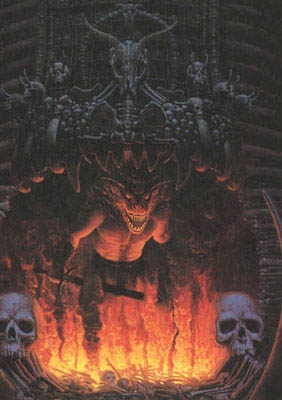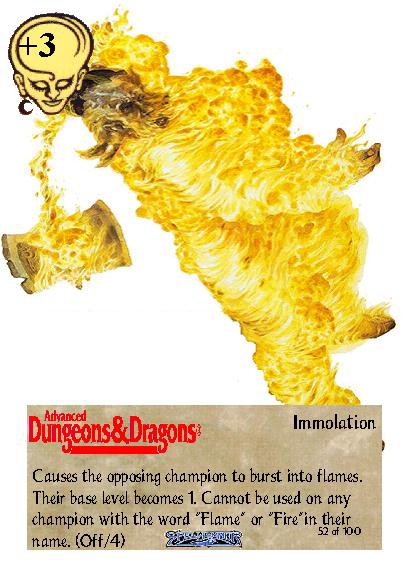(Alzoll, Balor, Errtu, Ndulu, Ter-Soth, Wendonai)
(Halls of Beol-Dur, H4 The Throne of Bloodstone, Novels of RA. Salvatore)


FREQUENCY: Rare
FREQUENCY:
Very rare ([Dungeon Level IX])
NO. APPEARING: 1-3 or 1-6
ARMOR CLASS: -2
MOVE: 6"/15"
HIT DICE: 8 + 8
% IN LAIR: 20% <H4, etc. : the lairs of some
of these might already be detailed>
TREASURE TYPE: F
NO. OF ATTACKS: 1 ~ 12
DAMAGE/ATTACK: 2-13
SPECIAL ATTACKS: Whip & immolate (2-12 /
3-18 or 4-24) <name them by size, add SPECIAL ATTACKS:, add LEVEL/X.P.
VALUE:>, magic use, psionics
SPECIAL DEFENSES: Hit only by magic weapons
MAGIC RESISTANCE: 75%
INTELLIGENCE: High
ALIGNMENT: Chaotic evil
SIZE: L (12' tall)
PSlONlC ABILITY: 180
Attack/Defense Modes: A, B,
C, E/F, G, H
LEVEL/X.P. VALUE: VIII | 3600 + 12
Each type VI demon has its own name. (Balor is
a type VI demon of the
largest size.) Six are known to exist. The favored
weapons of these
monsters are a large +1 sword and a whip
with many "tails." The latter
weapon is employed to drag the opponent into
the flames which the
demons are able to create around themselves.
Immolate:

During any combat there is
a two-thirds chance (1-4 on a 6-sided die) each
melee round that any type
VI demon will immolate and use its whip.
The two largest of these demons
do 4-24 hit points of damoge when a victim is
drawn within their flames,
the middle-sized and smallest do 3-18 and 2-12
respectively.
<confirm that this is a balrog>
They shed darkness in a 10' radius at will. Their
other singular abilities are:
Couse fear (as a fear wand), detect
magic <C or M?>, read magic,
read languages <(comprehend
languages)> <read languages is a Witch spell>,
detect invisible objects, <detect
invisibility>
cause pyrotechnics, dispel magic, suggestion,
telekinese 6,000 gold piece weight, use a symbol
of fear, discord, sleep or
stunning, and they also have a 70% chance of
successfully gating in a
demon of type III
(80%) or type IV (20%). Each of these terrible abilities
can be employed as often as desired, but only
one may be used at any
given time.
With proper invoking, offerings, and promises
type VI demons might be
convinced to co-operate with a character or group
for a time. Naturally,
the demon will attempt to assume/usurp command
at every opportunity.
Most chaotic evil monsters are drawn to the strong
evil charisma of this
creature, and of all its kind, the type VI demon
tends towards a more
organized evil (which makes it less than popular
with demon lords and
princes).
Aerial
Combat: 15", class D.
These two huge demon types [type IV & VI] will try
to bring their foes to the ground, much like nycadaemons.
Q: What is a balrog, and what are the statistics for it?
A: A balrog, as described in the Lord of
the Rings trilogy by J.R.R. Tolkien,
appears to be similar to lower planes
creatures like demons in the AD&D
system.
(Note that the original rules for the
D&D game did include mention of creatures
such as the balrog and the hobbit,
but those references were changed or
deleted in subsequent editions of that
game, and the terms do not appear in the
rules for the AD&D
system.) The Type VI
demon in the Monster Manual
resembles
the balrog, but is probably not as powerful
as a true balrog would be. If something
meant to be identical to a balrog is
to be used in a variant AD&D
game, the
DM will have to invent his own game statistics
for the monster after carefully reading
the various Tolkien books.
(79.16)
Grintharke is the ruler of Hellgate Keep in the North of the Forgotten Realms.
<Do Balrogs wear underwear?>
galvanize
Llaurenela wrote:
Hi Gary,
I have a few OD&D questions for you. From the 1st printing through the 6th printing, I know that the 5th printing still has hobbits, ents and balrogs and the 6th printing does not. I also know that the errata sheet applies to the 1st thru 4th printings and that the errata corrections were made starting in the 5th printing.
My questions are these: were there any text changes made between the 1st printing and the 2nd, 3rd or 4th printings? Were there any text changes made between the 4th printing and the 5th printing other than the errata being corrected? Is the 6th printing the first printing where changes were made due to copyright issues?
Just wondering if you had this information or not.
Thanks,
Llaurenela

The answers to your specific
questions are quite beyond me. That sort of thing was managed by the editing
people without consultation with me.
As to the removal of hobbit, ent, and balrog, that I can speak to. One morning a marshall delivered a summons to me as an officer of TSR. It was from the Saul Zaents division of ELan Merchandising, the sum named was $500,000, and the filing claimed proprietarial rights to the above names as well as to dwarf, elf, goblin, orc, and some others too. It also demanded a cease and desist on the publication of the Battle of Five Armies game.
Of corsue the litigant was over-reaching, so in the end TSR did drop only the game (the author had assured us he was grandfathered in, but he and his attorney too were wrong) and the use of the names hobbit, balrog, and ent--even though hobbit was not created by JRRT, and ent was the Anglo-Saxon name for giant.
Mike Carr is the chap most likely to be able to answer your technical questions.
Cheers,
Gary

Now as to the Type VI "Balors,"
in the whole of the Abyss there must be at least an average of 10 per layer,
the captains of the lords, so your 6,666 is a good estimate in my thinking.
Reference to six being known was indeed for purposes of knowing their names
for purposes of summoning. Lack of cooperation between Demon Lords means
that overall large numbers are not threatening to other planes...

Quote:
Originally Posted by haakon1
Halfling and treant are
clear, but what's a balrog in D&D? One of the devils, I suppose, or
perhaps you left it out entirely?

The balor demon, the name
borrowed from Celtic mythology....where I expect that "balrog" came from.